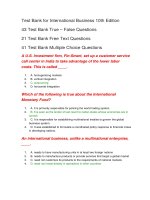Test bank for international business the challenge of global competition 12th edition by ball
Bạn đang xem bản rút gọn của tài liệu. Xem và tải ngay bản đầy đủ của tài liệu tại đây (168.28 KB, 50 trang )
Test Bank for International Business The Challenge of Global Competition
12th Edition by Ball
True / False Questions
1. A senior manager of a major multinational said that "no one will be in a general
management job by the end of the decade who didn't have international exposure and
experience."
True False
2. American companies want their managers to have a basic knowledge of international
business.
True False
3. CEOs of major American firms doing business overseas are not convinced the business
graduates they hire should have some education in the international aspects of business.
True False
4. Only those companies that have foreign operations need to be aware of what is occurring
globally in its markets and their industry.
True False
5. Firms with no foreign operations of any kind do not need managers with a global business
perspective.
True False
6. The United Nations uses the term transnational to describe a firm doing business in more
than one country.
True False
1-1
7. According to the text, foreign business denotes the operations of a company outside its
home or domestic market.
True False
8. According to the text, a global company is an organization with multicountry affiliates,
each of which formulates its own business strategy based on perceived market differences.
True False
9. According to the definitions in the text, a multidomestic firm is an organization that
attempts to standardize operations worldwide in all functional areas.
True False
10. The term in this text, "international company," refers to both global and multidomestic
companies.
True False
11. While international business as a discipline is relatively new, international business as a
business practice is not.
True False
12. The tendency toward an international integration of goods, technology, information, labor
and capital, or the process of making this integration happen, is referred to as economic
globalization.
True False
13. There are five major kinds of drivers, all based on changes that are leading international
firms to the globalization of their operations.
True False
1-2
14. Transnational corporations account for approximately 25 percent of total global output
and nearly 5 percent of world trade.
True False
15. Critics of large global firms compare these firms' sales with nations' total sales to illustrate
the tremendous size of these firms.
True False
16. In 2006, ExxonMobil's sales worldwide were greater than the gross national incomes of
all but the largest 19 nations of the world.
True False
17. When a global firm's total sales are greater than a nation's GNI, the national government is
defenseless against such a firm.
True False
18. One variable commonly used to measure where and how fast internationalization takes
place is the increase in total foreign direct investment.
True False
19. The world stock of outward foreign direct investment was $12.5 trillion in 2006, which
was almost 10 times what it was in 1980.
True False
20. Exporting refers to the transportation of any good or service to a destination inside a
country or region.
True False
1-3
21. Supporters of globalization generally argue that it is the best strategy for advancing the
world's economic development.
True False
22. Expanded international trade is linked with the creation of more and better jobs.
True False
23. Globalization has produced uneven results across nations and people.
True False
24. Opponents of free trade point out that globalization has contributed to a decline in
environmental and health conditions.
True False
25. International business differs from domestic business in that a firm operating across
borders must deal with three kinds of environments.
True False
26. The three environments for international business are domestic, foreign and export.
True False
27. Environment, as used in the textbook, is the sum of all the forces surrounding and
influencing the life and development of the firm.
True False
28. The environmental forces can be classified as internal and foreign.
True False
1-4
29. The external forces are commonly called uncontrollable forces.
True False
30. Management must administer the controllable forces in order to adapt to changes in the
uncontrollable environmental variables.
True False
31. The domestic environment is composed of all the controllable forces originating in the
home country that influence the life and development of the firm.
True False
32. The kinds of forces in the foreign environment are the same as those in the domestic
environment except they occur in foreign nations.
True False
33. The values of the foreign and domestic forces are identical, but the forces themselves are
different.
True False
34. A problem with the foreign forces is that they are frequently difficult to assess, especially
their legal and political elements.
True False
35. One part of the international environment is the interaction between the domestic and
foreign environmental forces.
True False
1-5
36. Those who work in the international environment find that decision making is not as
complex as it is in a purely domestic environment.
True False
37. The international environment is the interactions between the domestic and foreign
environmental forces or between sets of foreign environmental forces.
True False
38. Managers in the international environment find that decision making is easier because
foreign countries are smaller than markets in the United States.
True False
39. The self-reference criterion is probably the biggest cause of international business
blunders.
True False
40. An international manager has two choices on what to do overseas with a concept or
technique employed in domestic operations: (1) transfer it intact or (2) adapt it to local
conditions.
True False
Multiple Choice Questions
41. The increased internationalization of business requires __________ to have a basic
knowledge of international business.
A. all managers
B. managers of multinationals
C. managers of transnationals
D. managers of purely domestic operations
1-6
42. There is an emphatic need for all business people to have a basic knowledge of:
A. foreign travel.
B. international business.
C. the Pacific Rim.
D. foreign exchange.
43. According the text, American CEOs want business graduates they hire to have some
education in international business.
A. if they are going to work overseas.
B. if they are going to work in a firm with no foreign operations.
C. Neither A nor B because they can learn on the job.
D. Both A and B.
44. Historically, international business:
A. is relatively new.
B. existed before the time of Christ.
C. B and D.
D. was influenced by the rise of the Ottoman Empire.
45. As used in the text, a global company is an organization
A. that attempts to standardize operations worldwide in most or all functional areas.
B. that looks for differences among markets.
C. that is transnational.
D. all of the above
46. Firms that have substantial operations in more than one country are called
A. global companies.
B. multidomestic firms.
C. affiliated companies.
D. A, B, and C.
E. A and B.
1-7
47. An international business
A. is a business whose activities involve crossing national borders.
B. denotes the domestic operations within a foreign country.
C. is an organization with multicountry affiliates.
D. is an organization that attempts to standardize operations worldwide.
48. Foreign business denotes
A. a business whose activities involve crossing national borders.
B. the domestic operations within a foreign country.
C. an organization with multicountry affiliates.
D. an organization that attempts to standardize operations worldwide.
49. A multidomestic company is
A. a business whose activities involve crossing national borders.
B. the domestic operations within a foreign country.
C. an organization with multicountry affiliates.
D. an organization that attempts to standardize operations worldwide.
50. A global company (GC) is
A. a business whose activities involve crossing national borders.
B. the domestic operations within a foreign country.
C. an organization with multicountry affiliates.
D. an organization that attempts to standardize operations worldwide.
51. International business really began:
A. with the East India Company chartered in 1600.
B. when Singer Sewing Machine put up a factory in Scotland in 1868.
C. before the time of Christ.
D. when Colt Fire Arms set up a plant in England.
1-8
52. The major globalization drivers include all of the following except:
A. Political
B. Social
C. Technological
D. Market
E. None. All of the above are major kinds of globalization drivers
53. The trend toward unification and socialization of the global community is illustrated by
which of the following:
A. Preferential trading arrangements that group several nations into a single market.
B. Progressive increases in barriers to foreign investment by most governments.
C. Increased public ownership of much of the industry in formerly communist nations.
D. All of the above are aspects of the trend toward unification and socialization of the global
community.
54. UNCTAD, an agency of the United Nations estimates there are __________ international
firms in the world.
A. 5,500
B. 12,000
C. 64,000
D. 120,000
E. over 800,000
55. In 2006, only _______________ nations had GNIs greater than the total sales of
ExxonMobil.
A. 46
B. 19
C. 5
D. 76
1-9
56. Due to the expanding importance of foreign-owned firms in local economies, host
governments have made their policies toward these companies _______________.
A. more strict
B. more liberal
C. harsher
D. more confronting
E. A and C
57. Foreign subsidiaries must obey the local laws. If they don't, they are subject to:
A. legal action by the host country.
B. legal action by the host country and the country of the parent company.
C. seizure by the host government.
D. cancellation by the parent company of its right to do business in the host country.
E. A and C.
58. In 2006, the total amount of ExxonMobil's worldwide sales was greater than
A. the combined GNIs of 80 of the world's smallest economies.
B. the sum of the combined sales of Ford and General Electric.
C. the total sales of Wal-Mart Stores and Citigroup.
D. the sum of the GNI of the U.S.
59. In the United States, an overseas investment by an American resident is considered to be a
foreign direct investment if it is __________ or more of the stockholder's equity.
A. 10
B. 51
C. 25
D. 100
1-10
60. The worldwide stock of outward FDI is estimated to have increased __ between 1980 and
2006.
A. Threefold
B. Eightfold
C. Twelvefold
D. Seventeenfold
E. Twentytwofold
61. According to the text, one variable commonly used to measure where and how fast
internationalization takes place is:
A. the increase in a nation's population.
B. the increase in the number of new companies formed.
C. the increase in foreign direct investment.
D. the increase in international trade.
62. The level of service exports worldwide increased nearly __ between 1980 and 2007.
A. Fourfold
B. Sixfold
C. Ninefold
D. Twentyfold
63. According to supporters of the globalization of trade and investment, free trade
A. creates more and better jobs.
B. benefits all nations and workers.
C. does not cause the loss of high-paying jobs.
D. all of the above
64. According to opponents of the globalization of trade and investment,
A. globalization has produced uneven results across nations and people.
B. globalization has had harmful effects on labor and labor standards.
C. globalization has contributed to a decline in environmental and health conditions.
D. all of the above.
1-11
65. Environment as used in the textbook is the forces surrounding and influencing the life and
development of the firm and is classified as
A. controllable and uncontrollable.
B. domestic and foreign.
C. internal and external.
D. All of the above.
E. A and C.
66. Management has no direct control over the external environment of the firm but can exert
influence by
A. heavy promotion of new products to change cultural attitudes.
B. focus on the strategic plan.
C. lobbying.
D. All of the above.
E. A and C.
67. International business differs from domestic business in that a firm operating across
borders must deal with
A. C, D, and E.
B. C and D.
C. the foreign environment.
D. the international environment.
E. the domestic environment.
68. Examples of the kinds of uncontrollable forces listed in the text are:
A. competitive.
B. technological.
C. gravitational.
D. A and B.
E. All of the above.
1-12
69. The forces over which the management does have some command are called:
A. internal.
B. controllable.
C. foreign.
D. A and B.
E. B and C.
70. The domestic environment is composed of all the uncontrollable forces originating in the
__________ that surround and influence the life and development of the firm.
A. international arena
B. host nation
C. home country
D. foreign country
E. B and C.
71. Foreign environmental forces often operate differently than domestic environmental
forces because:
A. they are uncontrollable.
B. force values are different.
C. changes are difficult to assess.
D. B and C.
E. A, B, and C.
72. The kinds of forces in the foreign environment are __________ those in the domestic
environment except that they occur in foreign nations.
A. different from
B. the same as
C. less than
D. more stringent than
1-13
73. The international environment is the interactions between
A. the domestic environmental forces and the foreign environmental forces.
B. the foreign uncontrollable forces and the domestic uncontrollable forces.
C. the foreign environmental forces of two countries when an affiliate in one country does
business in another country.
D. both A and C.
E. All of the above.
74. Decision making in the international environment is __________ it is in a purely domestic
environment.
A. less complex than
B. less demanding than
C. more complex than
D. about the same as
75. According to the text, personnel working in a foreign subsidiary are working in the
international environment:
A. if they work and live in a foreign country.
B. if they are responsible for the subsidiary's exports.
C. if they are also responsible for the management of another foreign subsidiary.
D. all of the above.
E. B and C.
76. Unconscious reference to one's own cultural values when judging behavioral actions of
others in a new and different environment is called:
A. self-reference culture.
B. self-reference values.
C. self-reference criterion.
D. self-reference customs.
E. self-reference environment.
1-14
77. The international business manager can choose to:
A. transfer a management practice intact.
B. transfer and adjust a management practice.
C. not transfer a management practice at all.
D. A and B.
E. A, B and C.
Essay Questions
78. Considering the dramatic internationalization of markets, discuss the comment "no one
will be in a general management job by the end of the decade who has not had international
exposure and experience."
79. Discuss the differences of the various names given to firms that have substantial
operations in more than one country such as a global company, a multinational firm and an
international company.
80. Contrast the differences between firms of the early 1900s and present-day global
companies.
1-15
81. Identify and discuss the 5 major kinds of drivers that are leading international firms to the
globalization of their operations.
82. Explain why comparisons of nations and industrial firms by GNI and total sales,
respectively, can produce misleading results.
83. Discuss the arguments supporting and opposing globalization of trade and investment.
84. Discuss why and how international business differs from domestic business.
1-16
85. Discuss the three environments in which an international company operates.
Fill in the Blank Questions
86. Management must have _______________ _______________ to be able to meet the
challenge of global competition.
________________________________________
87. Some academic writers suggest using terms such as multidomestic and _______________
as synonyms for what others call a multinational.
________________________________________
88. The term __________ __________ is used to describe an organization with multicountry
affiliates, each of which formulates its own business strategy based on perceived market
differences.
________________________________________
89. The term __________ __________ refers to both global and multidomestic companies.
________________________________________
90. __________ __________ is business whose activities involve crossing national borders.
________________________________________
1-17
91. _______________ __________ denotes the domestic operations within a foreign country.
________________________________________
92. The tendency toward an international integration of goods, technology, information, labor
and capital, or the process of making this integration happen, is termed ____________
______________.
________________________________________
93. The five major kinds of drivers of globalization are _______, _________, ________,
_______, and _________.
________________________________________
94. International companies have _______ their participation in world trade since 1995.
________________________________________
95. _______ _______ _______ refers to direct investments into equipment, structures, and
organizations in a foreign country at a level that is sufficient to obtain significant management
control.
________________________________________
96. _______ refers to the transportation of any domestic good or service to a destination
outside a country or region.
________________________________________
97. __________, as used in the text, is the sum of all the forces surrounding and influencing
the life and development of the firm.
________________________________________
1-18
98. International business differs from domestic business in that a firm operating across
borders must deal with the forces of __________, __________, and _______________
environments.
________________________________________
99. Environmental forces can be classified as __________ or __________.
________________________________________
100. External environmental forces are commonly referred to as ___________.
________________________________________
101. Internal environmental forces are commonly referred to as __________.
________________________________________
102. The __________ __________ is composed of all the uncontrollable forces originating in
the home country.
________________________________________
103. The forces in the __________ __________ are the same as those in the domestic
environment except that they occur in foreign nations.
________________________________________
104. The ______ ______ is the interaction between domestic and foreign environmental
forces or between sets of foreign environmental forces.
________________________________________
105. A common cause of the added complexity of foreign environments is managers'
unfamiliarity with other cultures and is called __________-__________ __________.
________________________________________
1-19
Chapter 01 The Rapid Change of International Business Answer Key
True / False Questions
1. (p. 5) A senior manager of a major multinational said that "no one will be in a general
management job by the end of the decade who didn't have international exposure and
experience."
TRUE
AACSB: Analytic
Bloom: Knowledge
Difficulty: Easy
Learning Objective: 2
Topic: International Business Terminology
2. (p. 6) American companies want their managers to have a basic knowledge of international
business.
TRUE
AACSB: Analytic
Bloom: Knowledge
Difficulty: Easy
Learning Objective: 2
Topic: International Business Terminology
3. (p. 6) CEOs of major American firms doing business overseas are not convinced the business
graduates they hire should have some education in the international aspects of business.
FALSE
AACSB: Analytic
Bloom: Knowledge
Difficulty: Medium
Learning Objective: 2
Topic: International Business Terminology
1-20
4. (p. 7) Only those companies that have foreign operations need to be aware of what is
occurring globally in its markets and their industry.
FALSE
AACSB: Analytic
Bloom: Knowledge
Difficulty: Medium
Learning Objective: 2
Topic: International Business Terminology
5. (p. 7) Firms with no foreign operations of any kind do not need managers with a global
business perspective.
FALSE
AACSB: Analytic
Bloom: Knowledge
Difficulty: Easy
Learning Objective: 2
Topic: International Business Terminology
6. (p. 9) The United Nations uses the term transnational to describe a firm doing business in
more than one country.
TRUE
AACSB: Analytic
Bloom: Knowledge
Difficulty: Easy
Learning Objective: 1
Topic: International Business Terminology
7. (p. 10) According to the text, foreign business denotes the operations of a company outside its
home or domestic market.
TRUE
AACSB: Analytic
Bloom: Knowledge
Difficulty: Medium
Learning Objective: 1
Topic: International Business Terminology
1-21
8. (p. 10) According to the text, a global company is an organization with multicountry affiliates,
each of which formulates its own business strategy based on perceived market differences.
FALSE
AACSB: Analytic
Bloom: Knowledge
Difficulty: Hard
Learning Objective: 1
Topic: International Business Terminology
9. (p. 10) According to the definitions in the text, a multidomestic firm is an organization that
attempts to standardize operations worldwide in all functional areas.
FALSE
AACSB: Analytic
Bloom: Knowledge
Difficulty: Hard
Learning Objective: 1
Topic: International Business Terminology
10. (p. 10) The term in this text, "international company," refers to both global and
multidomestic companies.
TRUE
AACSB: Analytic
Bloom: Knowledge
Difficulty: Medium
Learning Objective: 1
Topic: International Business Terminology
11. (p. 10) While international business as a discipline is relatively new, international business as
a business practice is not.
TRUE
AACSB: Analytic
Bloom: Knowledge
Difficulty: Easy
Learning Objective: 1
Topic: International Business Terminology
1-22
12. (p. 12) The tendency toward an international integration of goods, technology, information,
labor and capital, or the process of making this integration happen, is referred to as economic
globalization.
TRUE
AACSB: Analytic
Bloom: Knowledge
Difficulty: Easy
Learning Objective: 1
Topic: International Business Terminology
13. (p. 12) There are five major kinds of drivers, all based on changes that are leading
international firms to the globalization of their operations.
TRUE
AACSB: Analytic
Bloom: Knowledge
Difficulty: Easy
Learning Objective: 2
Topic: Drivers of Globalization
14. (p. 15) Transnational corporations account for approximately 25 percent of total global
output and nearly 5 percent of world trade.
FALSE
AACSB: Analytic
Bloom: Knowledge
Difficulty: Hard
Learning Objective: 3
Topic: Growth of International Firms and International Business
15. (p. 15) Critics of large global firms compare these firms' sales with nations' total sales to
illustrate the tremendous size of these firms.
FALSE
AACSB: Analytic
Bloom: Knowledge
Difficulty: Hard
Learning Objective: 3
Topic: Growth of International Firms and International Business
1-23
16. (p. 15) In 2006, ExxonMobil's sales worldwide were greater than the gross national incomes
of all but the largest 19 nations of the world.
TRUE
AACSB: Analytic
Bloom: Knowledge
Difficulty: Medium
Learning Objective: 3
Topic: Growth of International Firms and International Business
17. (p. 15) When a global firm's total sales are greater than a nation's GNI, the national
government is defenseless against such a firm.
FALSE
AACSB: Analytic
Bloom: Knowledge
Difficulty: Hard
Learning Objective: 3
Topic: Growth of International Firms and International Business
18. (p. 17) One variable commonly used to measure where and how fast internationalization
takes place is the increase in total foreign direct investment.
TRUE
AACSB: Analytic
Bloom: Knowledge
Difficulty: Medium
Learning Objective: 3
Topic: Growth of International Firms and International Business
19. (p. 17) The world stock of outward foreign direct investment was $12.5 trillion in 2006,
which was almost 10 times what it was in 1980.
FALSE
AACSB: Analytic
Bloom: Knowledge
Difficulty: Hard
Learning Objective: 3
Topic: Growth of International Firms and International Business
1-24
20. (p. 17) Exporting refers to the transportation of any good or service to a destination inside a
country or region.
FALSE
AACSB: Analytic
Bloom: Knowledge
Difficulty: Medium
Learning Objective: 3
Topic: Growth of International Firms and International Business
21. (p. 20) Supporters of globalization generally argue that it is the best strategy for advancing
the world's economic development.
TRUE
AACSB: Analytic
Bloom: Knowledge
Difficulty: Easy
Learning Objective: 3
Topic: The Globalization Debate and You
22. (p. 20) Expanded international trade is linked with the creation of more and better jobs.
TRUE
AACSB: Analytic
Bloom: Knowledge
Difficulty: Medium
Learning Objective: 3
Topic: The Globalization Debate and You
23. (p. 21) Globalization has produced uneven results across nations and people.
TRUE
AACSB: Analytic
Bloom: Knowledge
Difficulty: Medium
Learning Objective: 3
Topic: The Globalization Debate and You
1-25









